This recipe was originally shared in 2014. Since that time, I’ve experimented with ways to improve this recipe, based on my own experience and reader feedback. In 2017, I shared a new and update recipe. Check out the new recipe, here.
Remember those chocolate chip cookies I posted this week? Yes, those ooey-gooey little bites of pure joy. It’s time to draw it back a little, finish up that last little crumb smudged with chocolaty goodness and talk about teeth and toothpaste. I know, a bit of a downer topic after talking chocolate, but I promise, you’ll want to stick around.
Growing up, I regularly visited the dentist, received protective sealants, braces, and cleanings. You could say the dentist and I were quite the BFF’s, maybe more like BDF’s (Best Dental Friends). My teeth were well-cared for, thanks to my parents.
With as many dental treatments as I received over the years, you’d think my teeth would be cavity-free and gorgeous. Cavitiy-free? I have many. Gorgeous teeth? Well, they are nice looking. Not once did I ever stop to think about what I was putting on my teeth and how it effects those pearly whites. For nearly twenty-eight years, I never once thought there was a different way to care for teeth. After all, commercials, the dentist, and pamphlets, tell us we need commercial toothpaste, two times a day, followed by a thorough washing of bright-blue mouth wash. And if that commercial toothpaste irritates your teeth, then the industry will sell you “special” commercial toothpaste.
After delving into Dr. Weston A Price’s book, Nutrition and Physical Degeneration and changing our diet to include lots of good fat, quite the shocker for a former margarine-loving vegetarian, I realized food has the power to heal and restore health. The difference real food made for our tired bodies, our son’s Apraxia, and even our dental health was amazing. Even with the real food change I continued to use commercial, processed products for our personal hygiene.
Here’s the thing about real food, natural living, getting back to simple, whatever you want to call it, eventually you start questioning all products. One day you pick up that bottle of lotion, after enjoying a nice glass of kombucha, and wonder, “Why can’t I pronounce anything on this bottle?” Soon, that bottle gets tossed and you’re experimenting with the same coconut oil used to make brownies, rubbing it all over your dry legs.
It doesn’t stop there, soon you’re tossing the foundation powder and whipping up a cocoa mixture to apply to your face. That foundation powder leads to body wash, homemade neosporin, vapor rub, and laundry soap. Your medicine cabinet resembles a hodge podge of natural ingredients and little mason jars with the only labels being hand-written. Your husband lovingly calls you “the witch-doctor” and your friends call you “crazy”.
Don’t think it will happen, friends? Give it a bit of time. Soon, you’ll be there too.
Today, I’m sharing a new recipe. One you can easily whip up with that hodge podge of natural ingredients. A recipe to replace yet another chemical found in our homes, toothpaste. A homemade toothpaste that’s revolutionized my teeth and dental health. This recipe is made with benonite clay. The same clay used to make foundation powder, rich is potassium and calcium and effective at removing toxins. Baking soda and coconut oil help to whiten and clean teeth. Mineral-rich salt is also added. Stevia and peppermint essential oil add a delicate, sweet peppermint flavor to the salty mixture. Each ingredient comes together to create a homemade toothpaste that cleans and nourishes teeth, in a simple, chemical-free fashion.
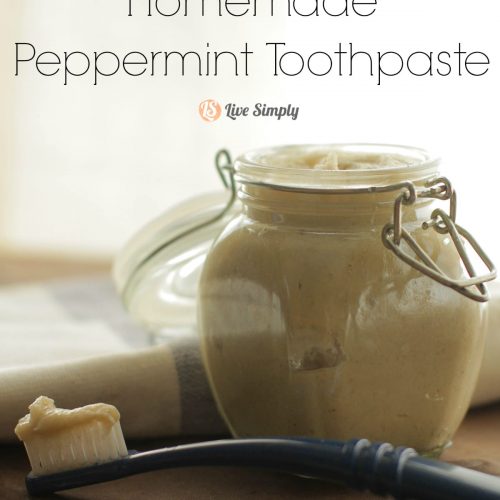
Simple Homemade Peppermint Toothpaste
Ingredients
- 3/8 cup coconut oil soft, but not liquid
- 1/4 cup baking soda
- 1/2 tsp salt
- 1 tsp bentonite clay
- 1/2 tsp liquid stevia optional
- 5-7 drops peppermint essential oil the amount will depend on taste preference
Instructions
- In a medium bowl, combine the coconut oil and baking soda. Mix thoroughly.
- Add the remaining ingredients and mix.
- Store in a jar and scoop with a small spoon (to prevent bacteria from entering the container). For a squeezable toothpaste, use a squeeze bottle.
- Note: When mixing bentonite clay, please use a wood or plastic spoon. Bentonite clay should not come in contact with metal because it deactivates the clay.
- The consistency of this recipe can vary depending on the temperature where the toothpaste is stored due to the nature of coconut oil.

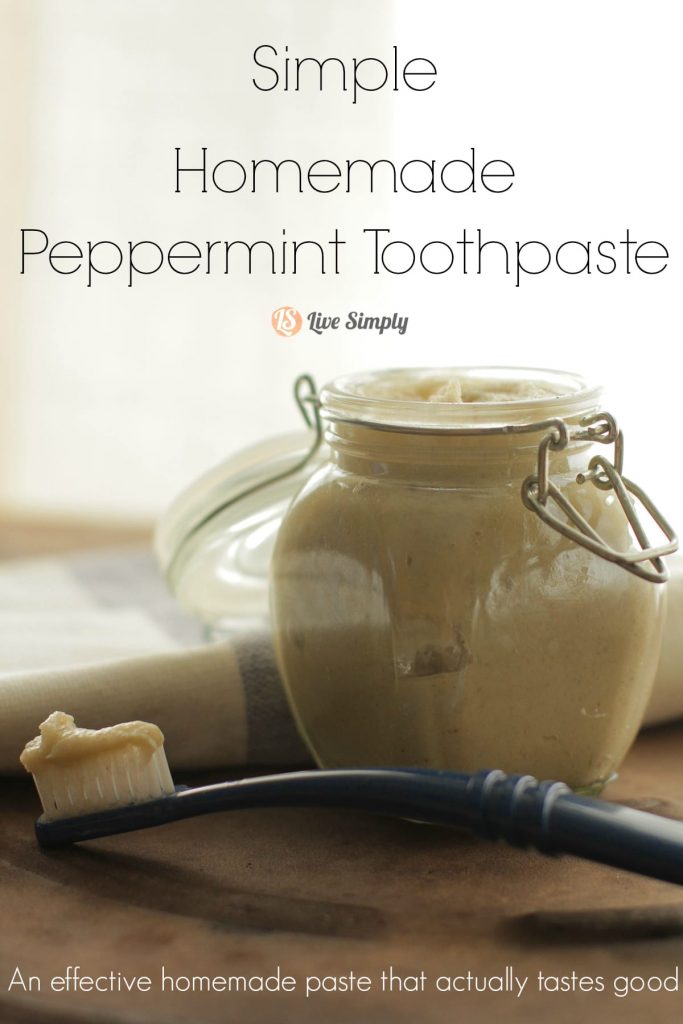
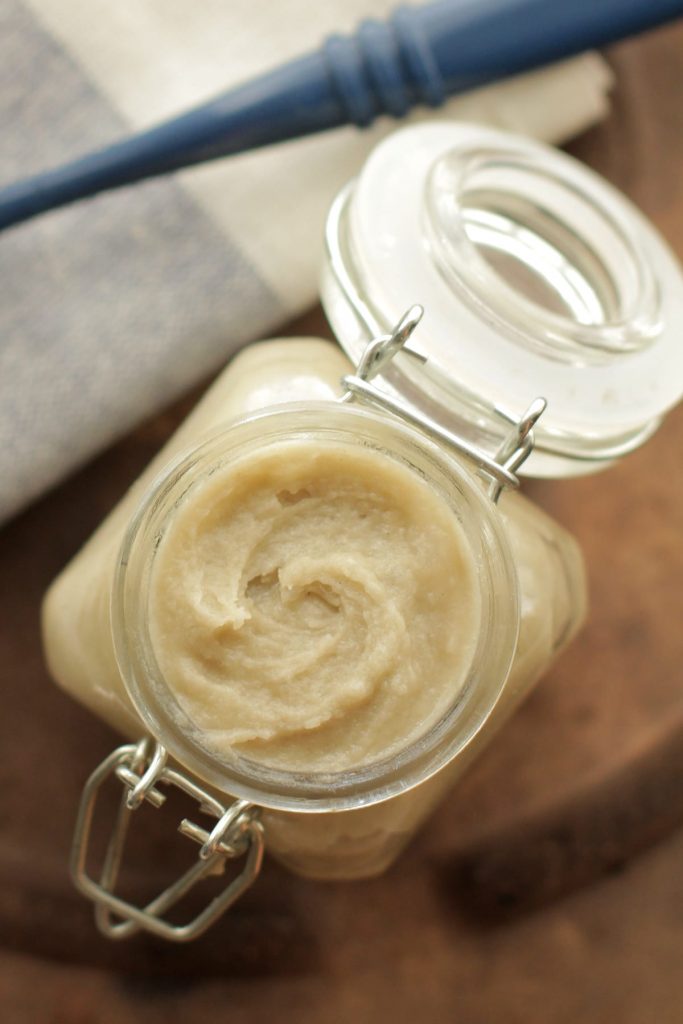
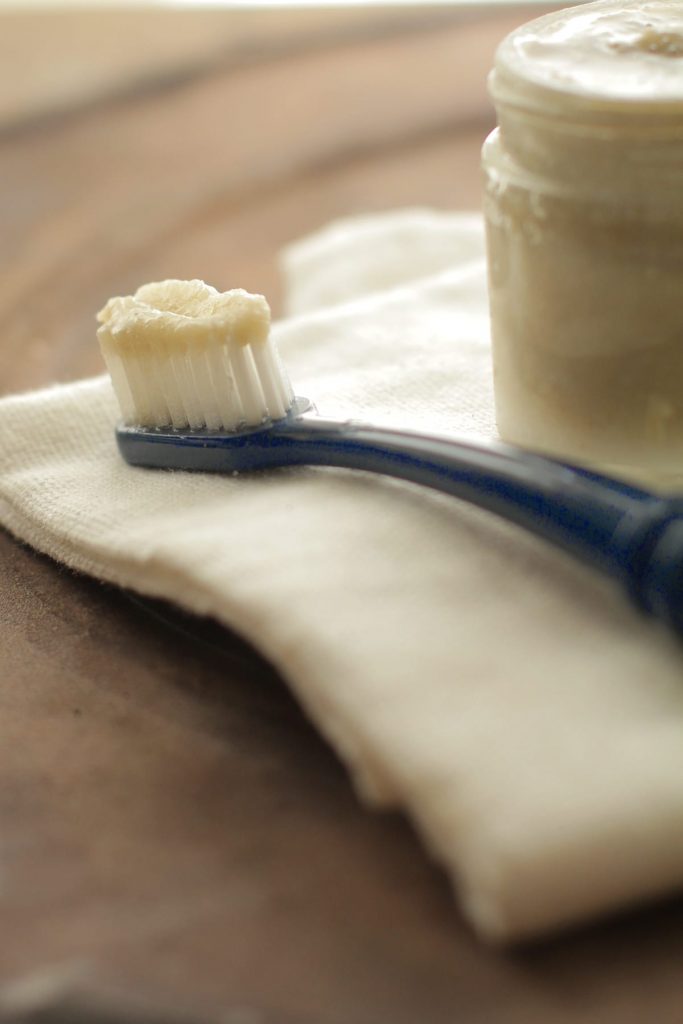
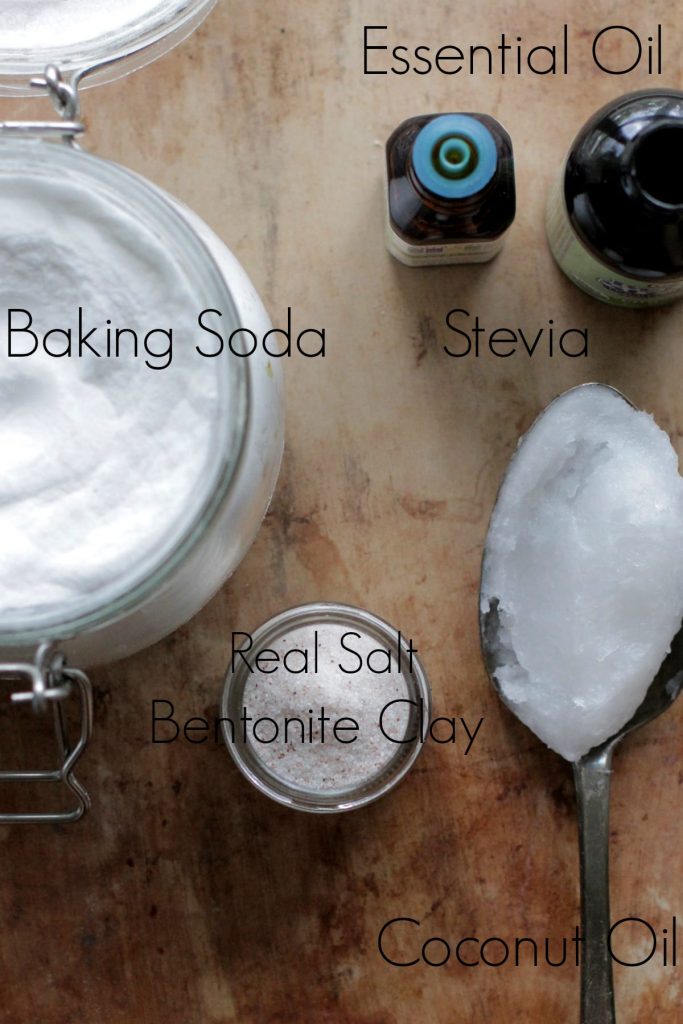
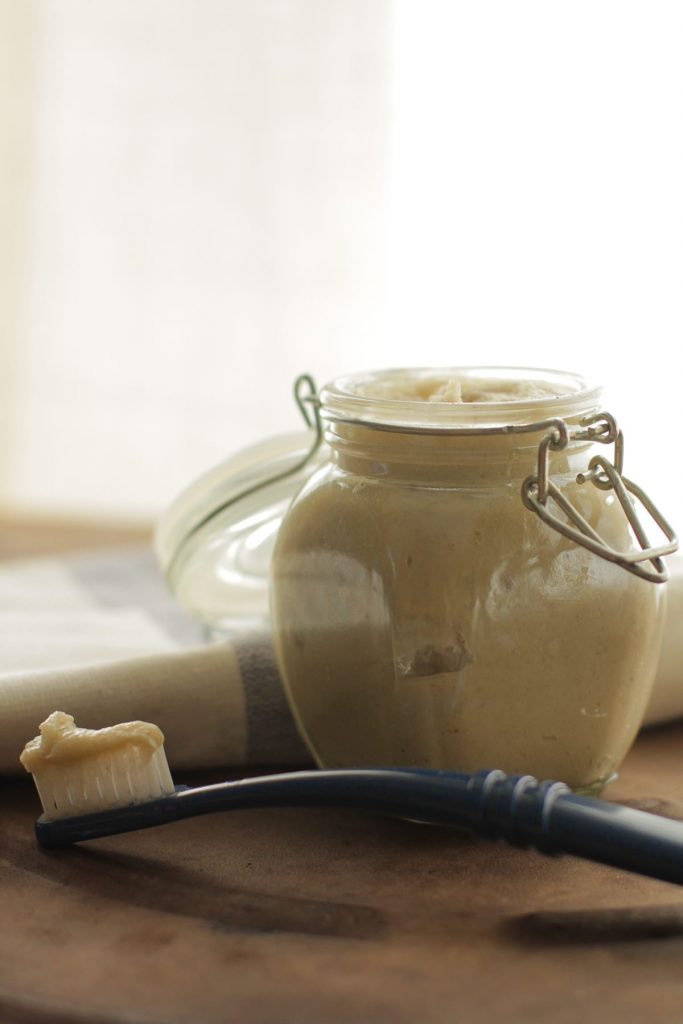
Is there a way to prevent the bentonite clay from coagulating?
Hey Angie, The coconut oil is the main culprit–it changes states as the temperature changes. The best way to keep it from coagulating is to try to keep the toothpaste at the same temperature–this may mean storing it in a cool cabinet, etc. I think this will take care of the bentonite issue which is probably caused by the coconut oil.
Hi! This might seem like a silly question, but I live in Brazil so sometimes while following recipes in English I have to search around to try and find out the names of ingredients around here, haha. So, from my research, real salt is the one with bigger grains, right?
Another thing: can I substitute Bentonite clay for any other one? Never seen it around here, I once asked a seller and she had no idea what it even was…
Hey Dhamirah,
Real Salt is a particular brand, but any salt that hasn’t been super processed (it still contains essential minerals) will work. I recommend going with a small grain salt for toothpaste. Usually a “real” or unrefined salt will have some color (pinkish) versus snow white.
For the bentonite clay, you may be able to use French green clay instead.
This works great! I don’t have essential oils or stevia yet, so I left them out and added 1/2 tsp mint extract. It doesn’t taste too bad, I was surprised, and I still get that cool minty-ness I’m used to. I love that this recipe doesn’t call for lots of ingredients that I would only use for toothpaste. I’m all about the multi-purpose ingredients, makes it worth the initial purchase I think. Thanks again Kristin!
Hey Bethany, I’m so glad you like the toothpaste. I love how most DIYs (at least around Live Simply ;)) call for ingredients that can be used to make multiple other recipes/DIYs! Enjoy!!
Hi i have tried baking soda aloNE but my teeth are very very sensitive and I have to use sensitive toothpaste all the time. I’m only 26 and I love doing healthikr things but this one I can’t seem to find something that works. I have alot of fillings as well and still have sensitivity. Do u know anyone that has that, that can use it?
Hey Chrissy, I don’t recommend using baking soda alone on the teeth. When mixed with other active ingredients, the baking soda shouldn’t hurt sensitive teeth. You could try reducing the amount called for in this recipe.
What a great recipe! I just use regular ol’ baking soda, but I miss that fresh peppermint flavor. I will have to try this. Also, I loved what you said about suddenly finding yourself whipping up all kinds of potions and lotions. My friends and family teased me when this started happening to me, and now they’re all asking for my natural skin care regimen, my deodorant recipe, and what I’m doing to look so gosh darn healthy. Who’s laughing now, eh??
I love it, Lindsay! Lol, it’s so true. One recipe always leads to another, and soon everyone wonders what you’re going to whip up next.
I made this the other day and my coconut oil was semi-liquid. I used the most “unliquid” parts of it I could get for the toothpaste. When I was done, the clay separated to the bottom of the glass jar and all the liquid is at the top. I can shake the container to mix them but its is the consistency of water. I bought all the ingredients as you listed them (some I already had from other DIY things I’ve made) except the oil. That was peppermint from a cake shop so I know it’s food grade. Any suggestion on why it would separate like that? I did mix in a plastic bowl with a plastic scraper before putting it in the glass jar.
Hey Diane, My guess is the toothpaste (and coconut oil) are stored in a warm environment. The coconut oil will liquify, even when mixed with other ingredients, if it’s stored in a warmer environment. Stirring the ingredients together before use is probably the best option right now.
I have a question about the salt, is “Real” just the brand name and its just pure Sea Salt or is there something special in this specific brand that’s worth buying instead? I have Kosher Sea Salt, can I use that instead? I am very excited to make this as my hubby literally just took all our toothpaste (he collected after many BOGO deals) back to the store! lol
Hey Teulia, Real Salt is a brand. This salt is not refined or stripped of minerals like most table salts. For this recipe you’ll want a mineral-rich salt (like Real Salt) and small granules. Depending on the kosher sea salt, the granules may be too big for this toothpaste.
Hello! I’m really excited to try this recipe! I have all the ingredients except the liquid stevia, I do however have stevia in powder form. Would this be an okay supplement? Also- would you please share where you found the adorable glass jar you use to store your toothpaste?I can’t seem to find one suitable! Thank you so much!
Hey Courtney, Powder stevia will work great as a substitute. You can also leave the stevia out (it just adds sweetness). I purchase many of my jars from the dollar section at Target or use small mason jars (Amazon or Target).
is this safe to use if you have metal fillings?
Hey Alicia, I use this toothpaste with one metal filling. Bentonite Clay is deactivated when it comes in contact with metal. I think the answer will depend on the number of metal fillings you have.
I’d love to try this, but added up the ingredients purchased from Amazon.com and they totaled over $70! I’m sure you could use the ingredients for other things, but that’s a big investment with the focus being a toothpaste. I think I will just continue to buy Tom’s.
Hey Lila, Yes, it can be a big investment. I’ll explain the expense from my experience…
I already use all of the ingredients for various other home/beauty products and even cooking purposes. I use stevia–which can be skipped, real salt, and baking soda in the kitchen. The bentonite clay is an amazing alternative to store-bought face masks (I use it weekly for a mask) and can be used to make homemade foundation powder. The essential oil is used in household cleaners to aid in cleaning. In the end, the ingredients actually save a ton of money because of their multiple uses vs. a tube of toothpaste, at least for us :).
Hi,
i want to make the toothpaste, but i happen to not have pepermint oil, is there another oil you recommend? TIA
Hey Mariana, You can skip the peppermint essential oil (it’s mainly for flavor), or use orange essential oil.
I love the toothpaste but have noticed my bathroom sink drais slow now. Could it be the coconut oil in the toothpaste?
Hey Debbie, I’m so glad you like it. Yes, that issue may be caused by the coconut oil (particularly if you live in a state with cold temperatures). You may want to try spitting the toothpaste in a trashcan.
Hi! Kind of a silly question but I was wondering how you get the toothpaste out of the jar? Do you use a spoon or just dip your toothbrush into the jar? And if so are you concerned about spoiling the toothpaste by transfering bacteria from your toothbrush into the toothpaste? Thanks!
Hey Birthe, Not silly at all :). For my kids’ toothpaste, I use a squeeze bottle (mentioned in the kid toothpaste recipe). For the “adult” toothpaste, a little spoon is kept in the bathroom for scooping toothpaste. I’ll admit there are lazy times when I scoop straight from the jar with the toothbrush, but I’m sure it’s not the most hygienic practice.
Thanks Kristin—I will look at that article.
In the meantime, yesterday I made your liquid hand soap and am so delighted with it!
You’re welcome, Havely. The liquid hand soap is my favorite DIY!! Enjoy!
First of all, thanks so much for your blog. Yesterday I made your laundry detergent and washed my first load today. It smelled so good and cleaned so well!
I now really want to make a homemade toothpaste, but I have two questions: 1) On another site, a dentist commented that baking soda is too abrasive to use as a toothpaste, so that made me hesitate and 2) My husband thinks fluoride is an essential ingredient for toothpaste and is concerned if I switch our family to homemade for this reason. Do you have any links to research etc. that may help alleviate these concerns on our part?
Thanks again!
Hey Havely,
I’m so glad you like the laundry soap.
Fluoride can be a tricky and very controversial topic. I’ve done a lot of research and still find I’m not 100% for or against fluoride. My dentist (and many others I’ve talked to) claim a child without any fluoride will experience more cavities than a child brushing with fluoride. There aren’t many professional articles on the topic via the internet (and it’s often hard to know if the studies found have been paid by a company or interest group), just books briefly discussing the topic. Dr. Mercola (there are mixed opinions on him, but I enjoy his information) has written several articles, here’s one: http://articles.mercola.com/sites/articles/archive/2013/04/30/water-fluoridation-facts.aspx. I personally choose to have my kids get the fluoride treatment once a year during their annual cleaning appointment, but don’t want them getting fluoride daily in our water and toothpaste.
Hello, I was just wondering if there was a baby safe alternative to stevia that doesn’t cost the earth?
Thank you very much 🙂
Hey Jennie, The stevia is added for sweetness and helps as children transition from store-bought (super sweet) toothpaste to a homemade version. It can be left out. Xylitol is another option, although the amount added will differ.
Ooops. Just saw this covered in the post above, thanks 🙂
Just curious how people deal with the homemade toothpaste in the winter. Our toothpaste is pretty solid (because it’s made with coconut oil) and even though I use a wooden spoon to scoop it out, it’s a bit hard to brush with since it’s more crumbly and less paste-like.
Does this get too hard when weather get colder, and vice versa in the hotter temperatures?
Hey Tammy, I live in Florida, so I don’t experience a a wide variety of temperatures, but the coconut oil will harden a bit in the cold, and soften in the heat (not to a liquid state). You could try whipping the mixture with a whisk attachment on a mixer as that may help the toothpaste stay soft in the freezing cold.
I live in San Francisco and the weather is usually cool so our bathroom is normally around 55-60 degrees. My mixer is metallic and you’ve already mentioned not using metal with the clay. But I don’t know how to get around having an almost solid toothpaste though I’ve already made my first batch. It crumbles.
Hey Marjorie, Did you melt/soften the coconut oil? That may help with the mixing. You can also add more coconut oil until you reach the desired consistency.
I softened it, but I’ll try melting it. Thank you for the suggestion!
You’re welcome! Let me know how it goes :).
Hi! Can I substitute the essential oil for organic peppermint flavor? The pepper mint flavor has organic sunflower oil and organic peppermint oil. The only reason I am considering this is because I cannot find a food-grade peppermint oil.
Hey Sarah, You can use peppermint flavor. I know Frontier makes a good peppermint flavor that I use during the holidays for baking.